Remarketing Dynamics
How to Optimize your Remarketing Campaign?
A Digital Marketing Case Study
In the previous blog post about the fundamentals of remarketing dynamics we looked at the feedback structure which is driving the change of the remarketing audience list over time. Maybe you have taken the one-minute quiz and checked your awareness, knowledge and intuition about these dynamics.
In this blog post I want to go a bit deeper in the question
How does an optimized remarketing campaign look like?
We will use a case study example and cover these topics:
- What are the objectives of the optimization?
- What is the baseline case? How does the campaign play out before optimization?
- Which levers can we pull to optimize the campaign?
- What is the impact on performance and results of an optimized remarketing campaign?
More about this topic can be found in the related briefing and group coaching center. Also, check out the "idea,-" podcast series. And the recorded sessions from webinars will be made available on the YouTube channel.
Choosing the optimization objective
The starting point of any optimization should be the optimization objectives and the baseline scenario.
The objectives for the optimization can be different and really depend on the specific situation. For example, you can optimize around these parameters:
Customer Base Growth
This objective applies when you want to grow your customer base regardless of other parameters. For example, when the Life-Time-Value (LTV) of your customers is high, you may want to win as many as you can. Accelerating customer base growth is a key strategy for any SaaS (Software-as-a-Service) business.
Market Share
Optimizing for market share makes sense when you are moving in market where you want to set the standards. For example, if you are offering a new technology platform with new tools, you want to make sure that your product becomes the de-facto standard. When you are the volume leader, you can drive the standards.
Standards follow Volume
If you are in an inferior position, then the chances that you can push for new standards are pretty slim. You can see this phenomenon in the market for operating systems for mobile phones and desktop PCs.
Time to attain market share
Timing can be a key factor. If the market is attractive and new entrants are coming quickly then your goal may be to win superior market share position quickly. This can be a good strategic move when there is a path dependence in the market situation. Take a look at past examples in the video console and PC markets. During the early phases the players were on par with respect to market share. But once a competitor had the lead and was able to tilt the momentum to their advantage, the entire market shifted in their direction.
Cost of marketing
When you are focused on sticking to your marketing budget then the goal may be to contain the ad spend. Most companies have a constraint in this area. Especially when there is no mechanism ond management rule in place to re-invest a portion of the revenue in marketing. Also, you may want to consider how much to invest in the different sales and marketing channels.
Also, not-for-profit organizations typically focus their attention around optimizing for reach and cost.
Revenue
Optimizing for revenue applies for example when you want to bring in a lot of cash in a short time. This is an important consideration when you are reporting recognized revenue as one of your KPIs. But also, from a competitive perspective you may want to capture as much available customer budget as possible to make sure customers are not buying products from your peer competitors.
Profitability
Maximizing profitability is the objective which applies to most businesses. At the end of the campaign it matters if you drove profitable growth. If you bring in a lot of customers but your customer acquisition costs are going through the roof, then you will probably not be in a good spot.
Dynamic multi-objective optimization
The digital marketing campaign is a complex system with highly dynamic change over time, as we have discussed in the related post. Therefore, it is important to consider these dynamics in the optimization.
And the optimization around a balanced set of goals is also more realistic. For example, you may want to optimize your campaign for
- Highest possible number of customers.
- Shortest time to acquire customers.
- Maximizing the profit contribution.
The dynamic, multi-objective optimization is the holy grail of improving digital marketing campaign performance.
In addition, we need to consider uncertainty in our planning and optimization. The customer behavior and hence our KPIs fluctuate over time. For example, the CTR (Click-Through-Rate) may be 4% on average but fluctuate between 0% and 10%. But more about that in another blog post.
Case Study: Remarketing Dynamics Simulation
Let’s take a look a case study. We’re using a dynamic simulation to explore the optimization. This is a good way to learn about the dynamics in a risk-free environment. In other words, you can explore a situation without spending your money on it.
Technically speaking, this is based on system dynamics simulation. If you are interested in the modelling part, we can discuss this in briefing center.
The case study will play in the following market situation:
- You have a target market of 2’000 customers.
- The product price is 1’000,- per unit.
- And you have an available budget of 1M.
The campaign KPIs have the following characteristics:
- CPC: Remarketing ads are somewhat less expensive with 1.50 per click versus 2.- per click for regular ads.
- CTR: Click through rates are the same for both regular and remarketing ads.
- Conversion: The remarketing ads convert better with 8% versus 5% for the regular ads.
These settings map closely to a lot of campaign settings.
In our simulation we are not considering the impact of list membership duration on these values. The probability that a customer converts remains stable during the retention period.
Baseline performance scenario
In starting point for the campaign is to
- Set the remarketing list retention period to 30 days,
- Spend 10’000,- per day
- Split the ad spend in 80% on regular ads and 20% on remarketing ads.
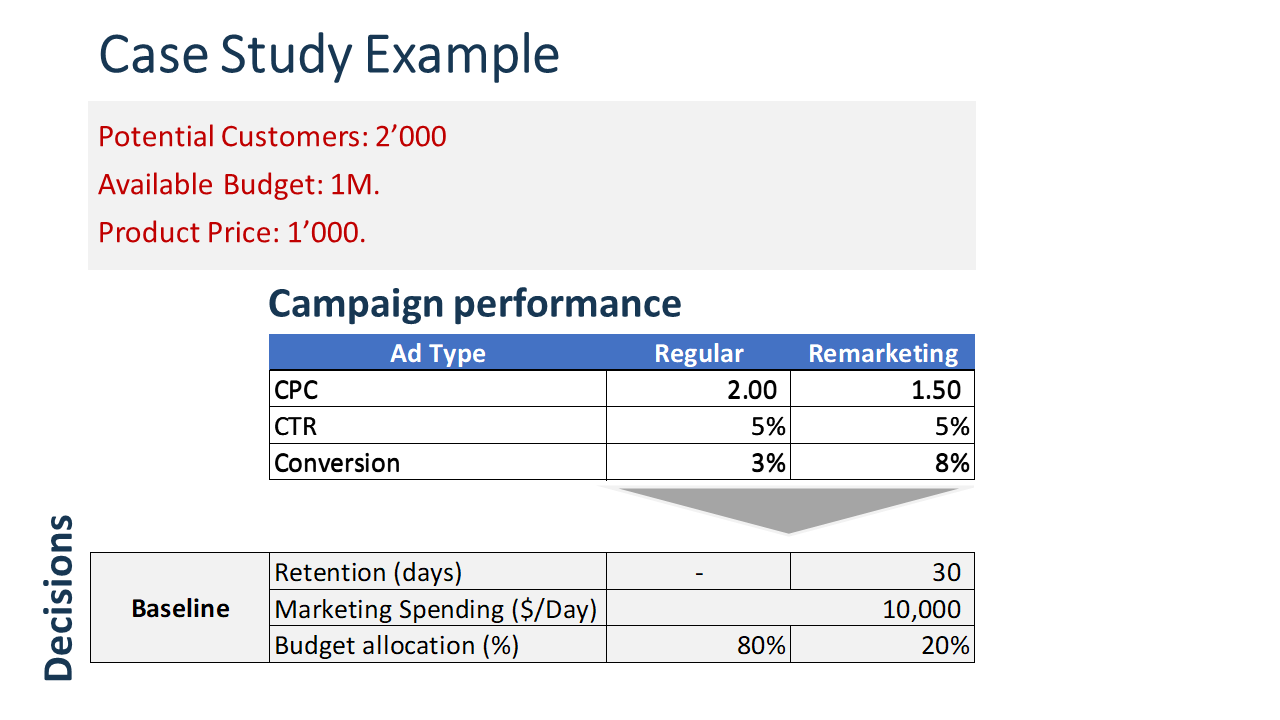
Remarketing Simulation Case Study
Simulation results
Here is what we get with these settings:
The budget is burning down over 100 days with the 80-20 split.
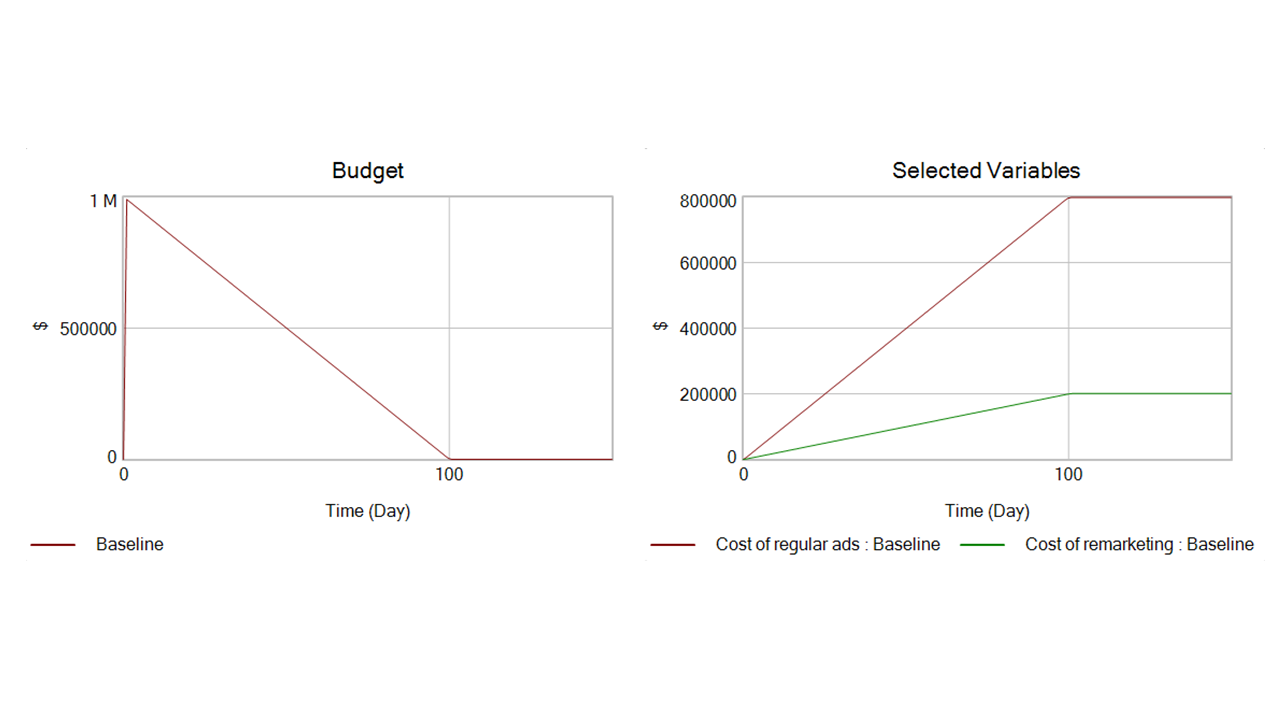
Remarketing Simulation ad spending
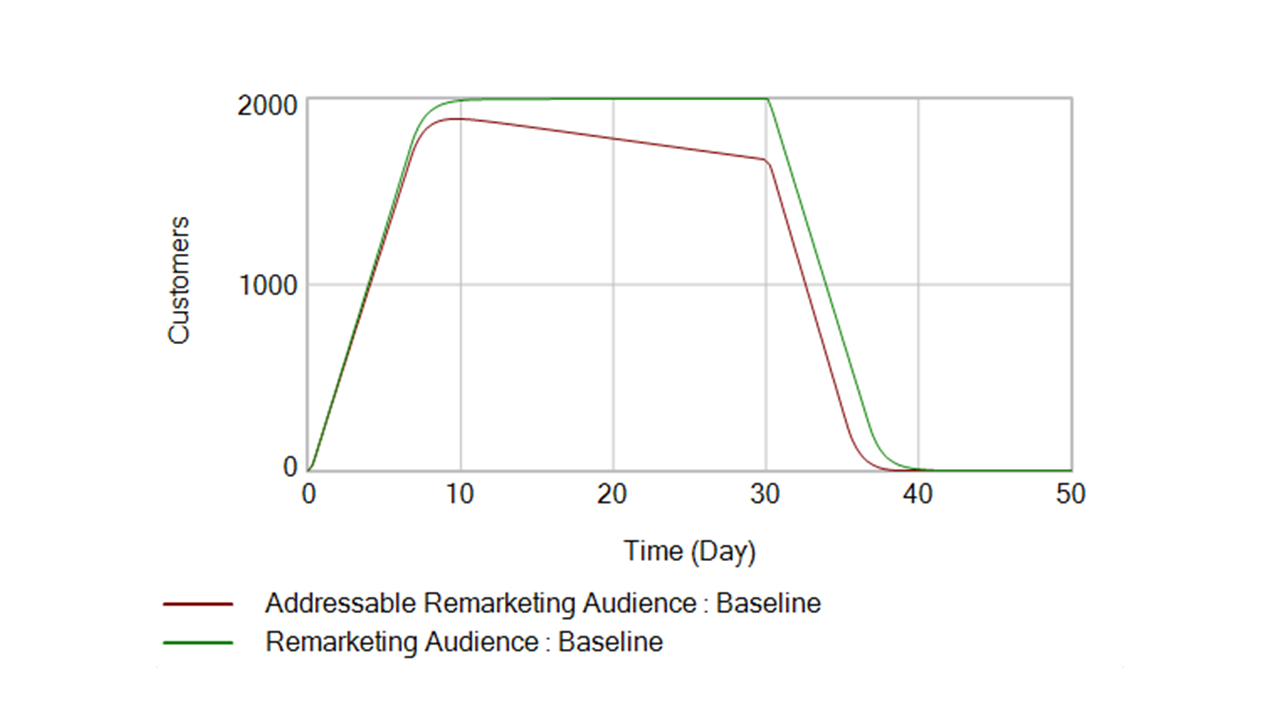
Remarketing audience change over time
We captured a portion of the market. But after the budget is exhausted, there is a significant number available in the market.
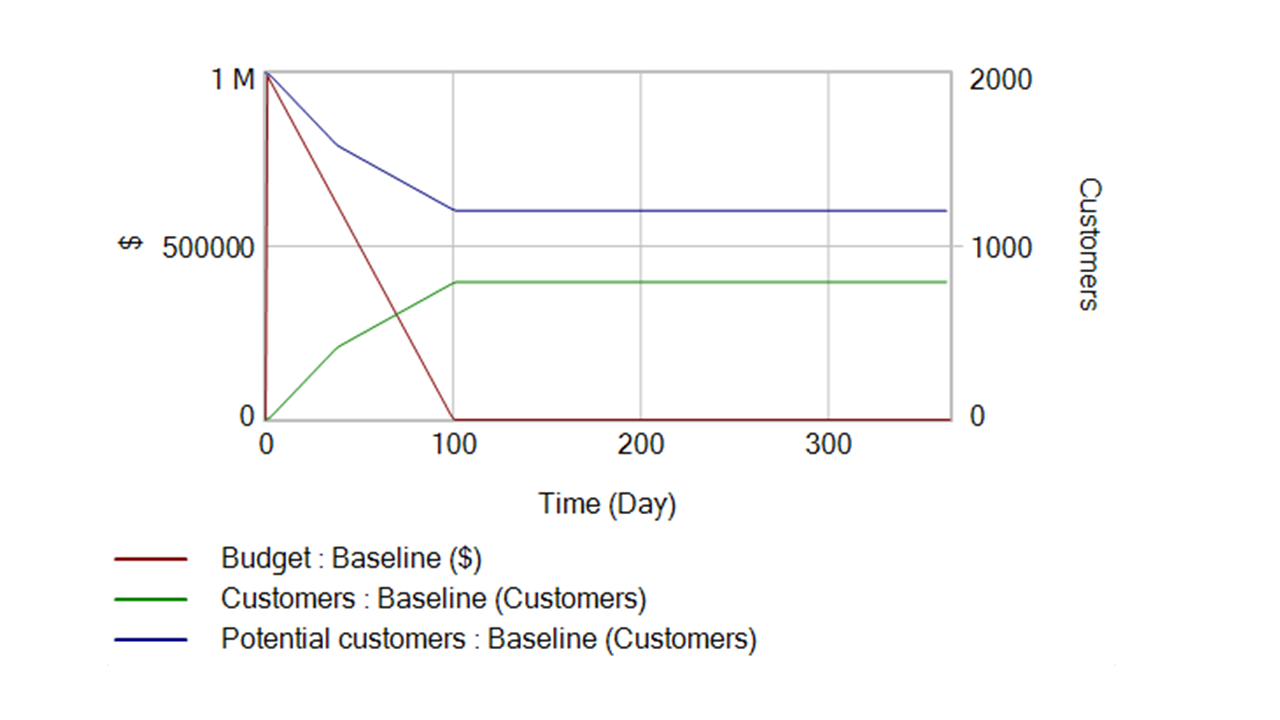
Performance scenario. Market potential not captured.
And at the end we captured only 40% of the market and our campaign generated a loss.
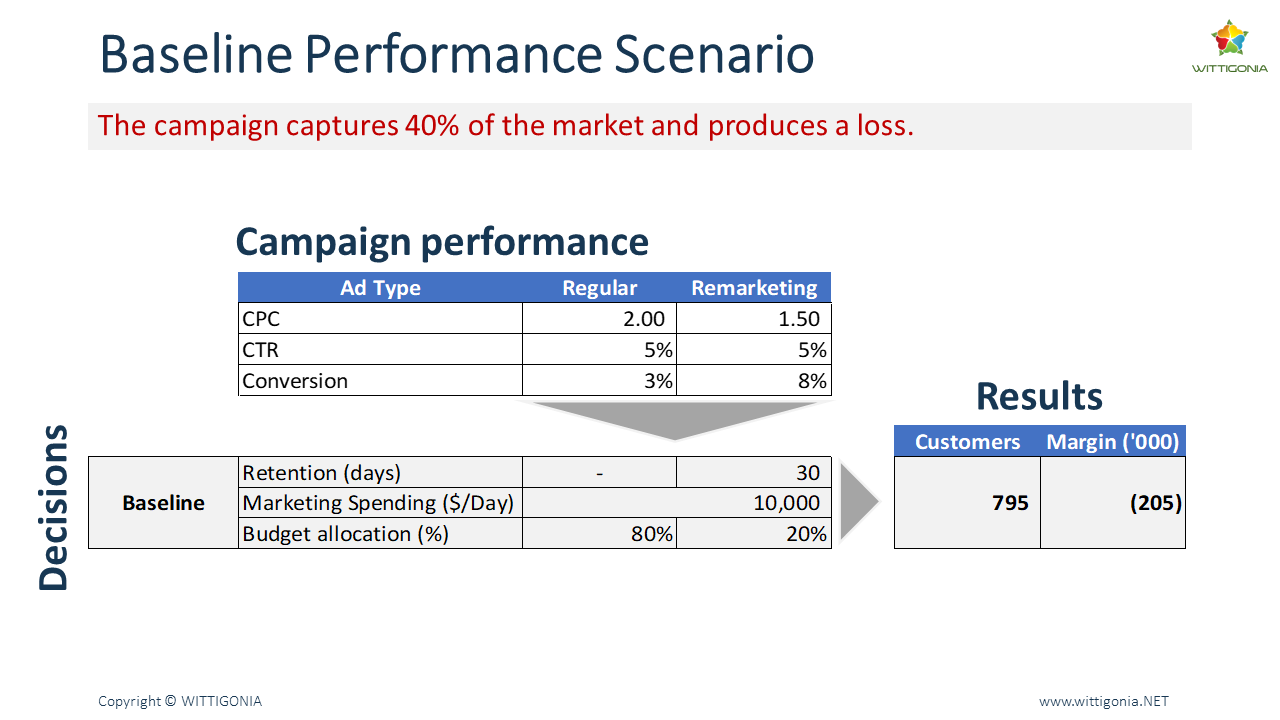
Baseline scenario results
Optimized performance scenario
In the optimized campaign
- we spend faster on both the regular and remarketing ads with 15’781,- per day.
- we extend the retention period from 30 to 180 days.
- and we shift the budget allocation towards 93% on remarketing and 7% on regular ads.
Again, this is a simulation for illustration purposes. Every situation is specific, and you should always test your campaigns before you’re going all in!
But let’s see what happens in this performance scenario:
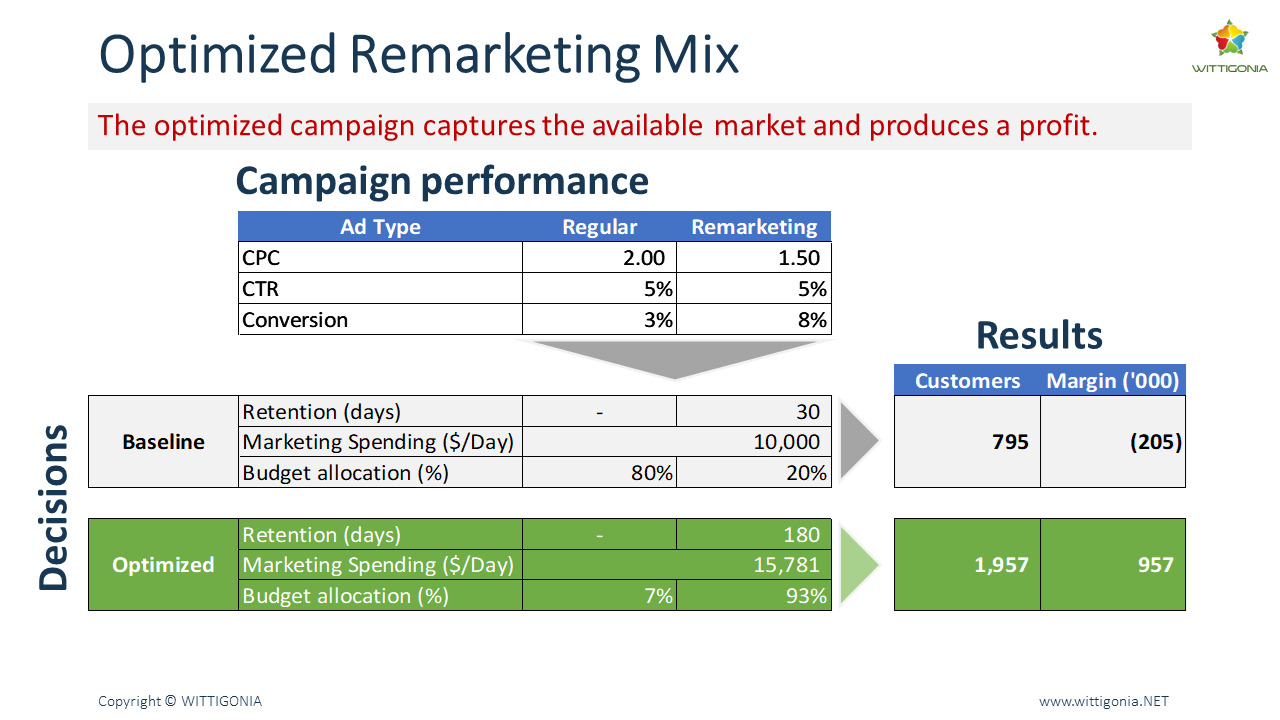
Optimized remarketing campaign results
The simulation results look much better.
Why and how did this happen?
As we are keeping customers on the retargeting list for a longer time and we are spending more heavily on remarketing, we are leveraging the addressable remarketing more heavily and it is depleting faster. As we discussed in the previous post, the addressable remarketing audience are all customers who are available and have not yet purchased the product.
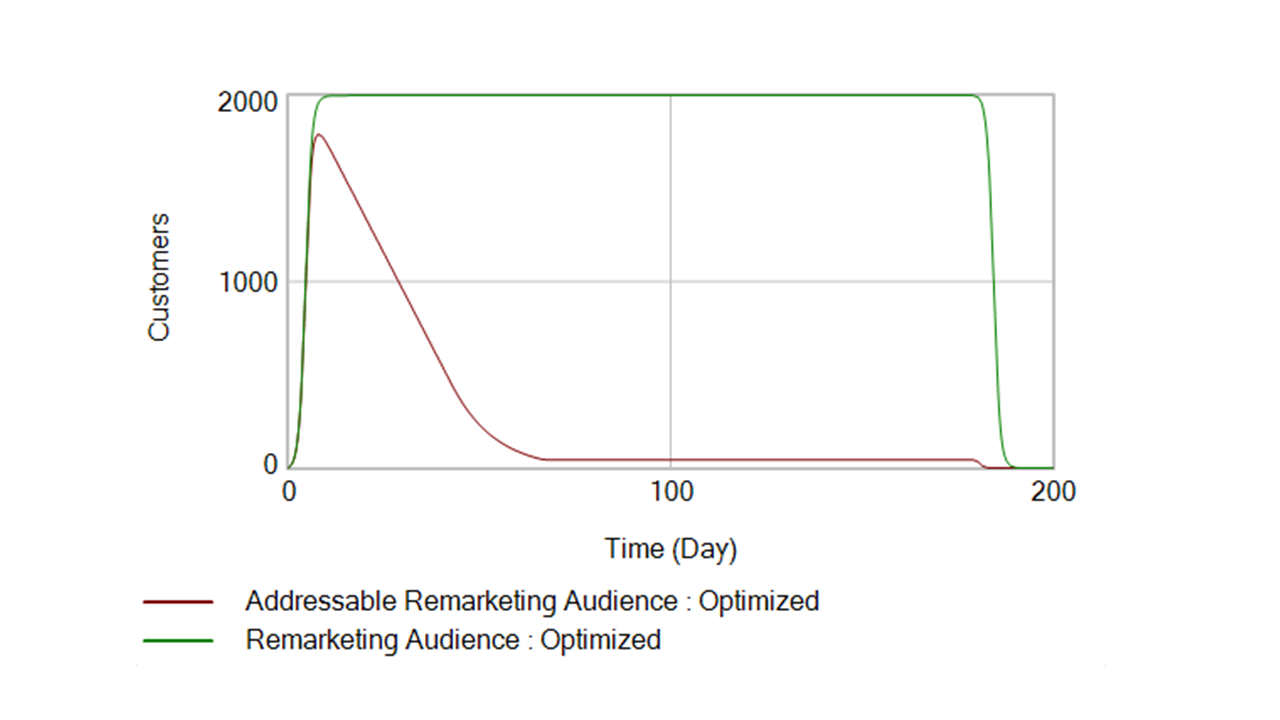
Addressable remarketing audience change over time
This translates into an accelerated customer acquisition and we are able to win more customers faster. That is already a visible difference to the baseline performance scenario.
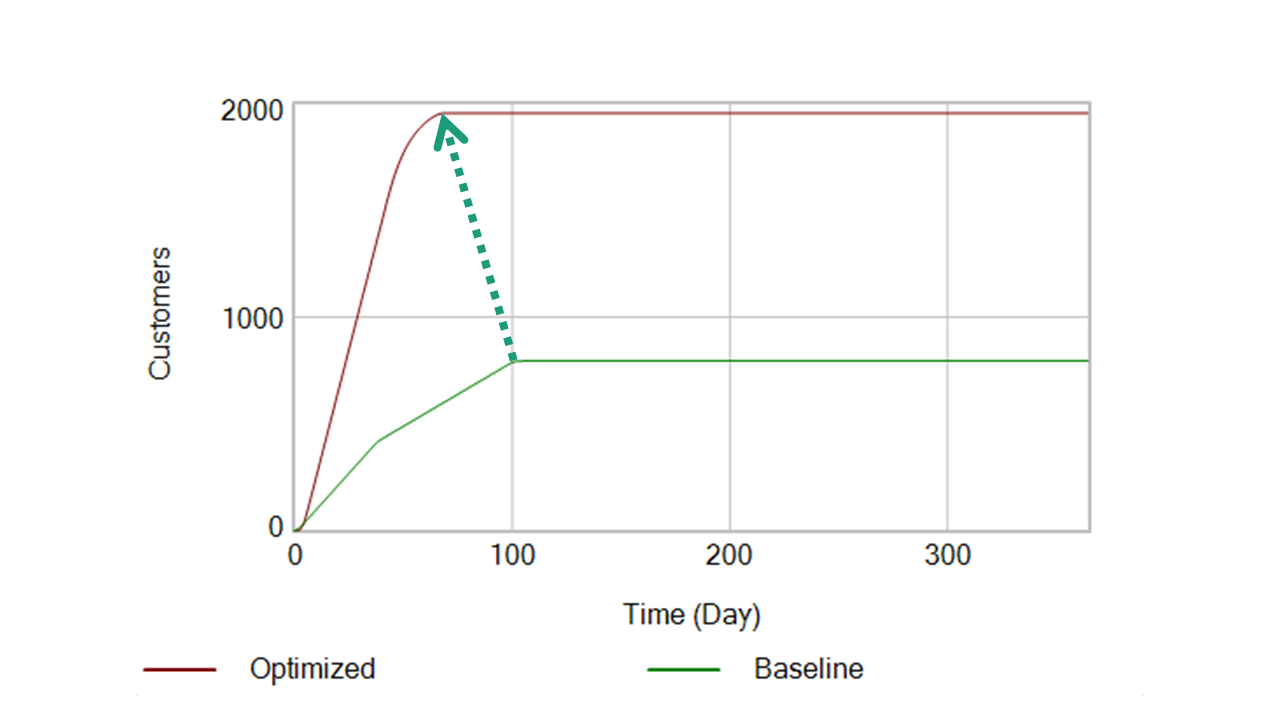
The optimisation of the campaign leads to a much higher capture of market share in an shorter time period.
On the financial side the faster acquisition generates an increased flow of revenue. On the cost side we are spending the same budget but just faster than in the baseline scenario.
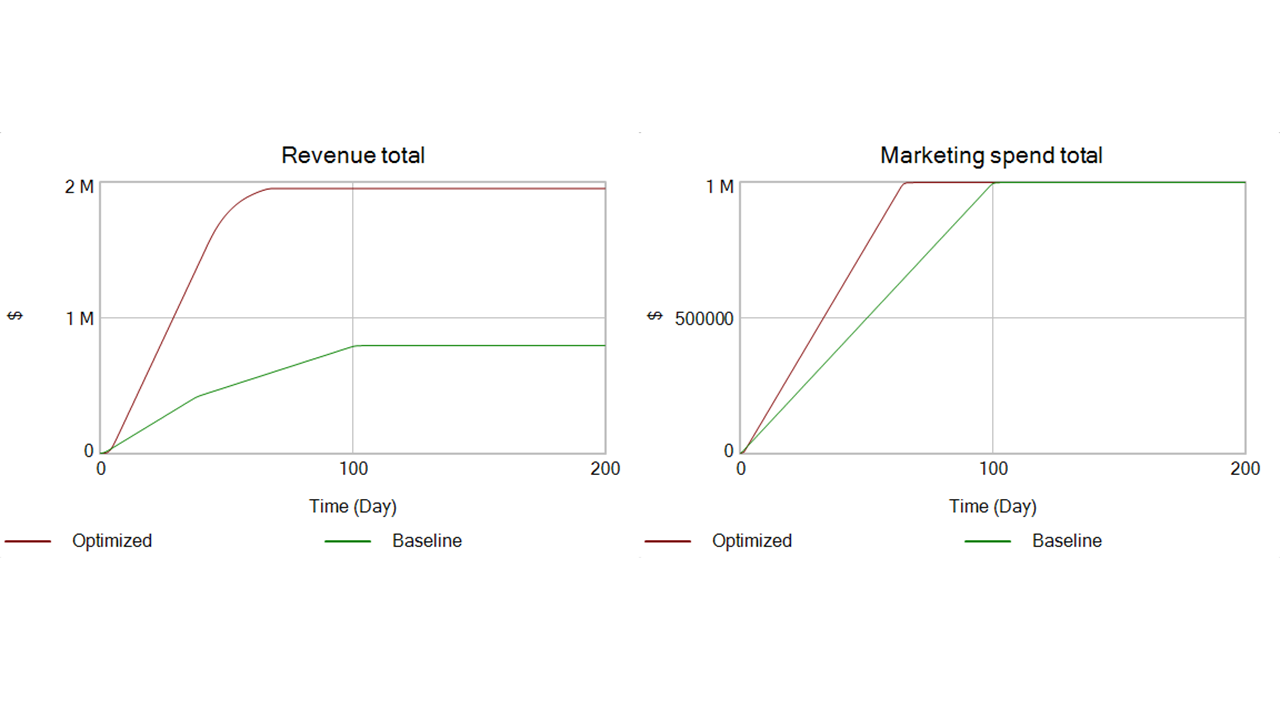
Financial performance over time
The results are very different from the baseline case. We are able acquire more customers, almost the entire market, and we generate a positive profit contribution with this campaign.
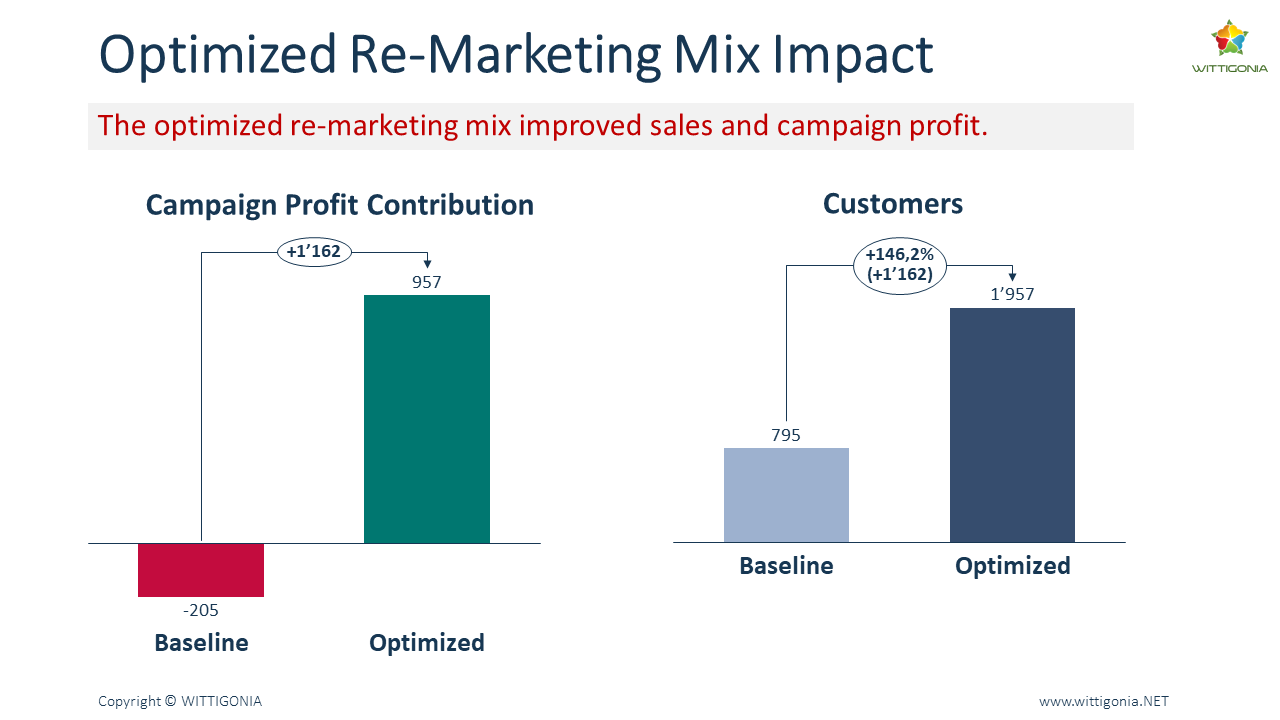
Optimized Remarketing Mix and Impact.
The impact is more than favorable and it suggests that in this particular setting the better performance can be achieved with a
- Faster spending,
- higher spending on remarketing,
- longer retention period.
Which factors influence the optimization of your campaign?
The optimized setting depends on the relative performance of the KPIs: CTR, CPC, Conversion rate. Depending on the combination and variability of these parameters, the optimal solution can be very different.
In this example case study, we have not considered how a longer retention period affects the conversion ratio. And there is no rule of thumb which applies to every situation:
- It may very well be that customers have the same likelihood to purchase over the period of time when they are on the list.
- It is also possible that customers are more likely to buy when they have seen your ads several times. One school of thought suggests that prospects see an ad 7 times before they convert.
- It could also be that there is an ad fatigue – especially when customers see the same ad over and over again. This could be even very annoying. Therefore, it is good to keep an eye on the frequency ration – a metric which tells you how often customers see the same ad.
The KPIs such as CTR, CPC and conversion ratio are subject of variation over time. In another blog post we explored this topic. We can and should apply the same logic to the dynamic optimization. This will require yet another set of simulation experiments. How about we cover this in a future blog post?
Conclusion
With an optimized remarketing mix and campaign settings you can boost the performance of your digital marketing campaign. With the wrong settings you can lose money. And the right settings and timing can make the difference between a disaster and a high-performance campaign.
Consider these decisions when planning and adjusting your campaign:
- Timing of the regular ads.
- Timing of the remarketing ads: when to start and when to stop.
- Level of daily ad spend.
- Allocation of marketing spend on regular and remarketing ads.
- Duration of the retention time: how long to keep customers on your remarketing list.
The optimal settings can be either obtained through setting up controlled experiments or through dynamic modeling and optimization based on historical data and your assumptions. The optimization should be carried out during your campaign and of course before you even start. It is another good way to figure out how much budget you will need when.
TL;DR
Choose the objective for optimization. Simulations are a good starting point. With an optimized remarketing mix you can acquire more customers faster and improve bottom line results.
